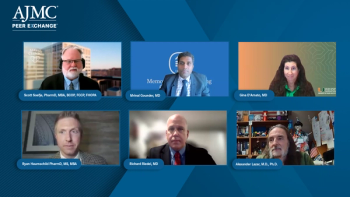
Patient Selection Vital in Ensuring Improved Response to PD-1, PD-L1 Inhibitors in NSCLC
A late afternoon extended education session on the first day of the 2017 American Society of Clinical Oncology Annual Meeting in Chicago, Illinois, was a discussion on the state-of-the-art uses for immunotherapy in the management of non-small cell lung cancer (NSCLC).
A late afternoon extended education session on the first day of the 2017 American Society of Clinical Oncology Annual Meeting in Chicago, Illinois, was a discussion on the state-of-the-art uses for immunotherapy in the management of non-small cell lung cancer (NSCLC). Oncologists shared their experiences with the management of toxicities resulting from immunotherapy, and also discussed the role of immunotherapy in specific patient populations.
Edward B. Garon, MD, director of the thoracic oncology program and associate professor of medicine at the David Geffen School of Medicine at University of California Los Angeles, spoke about using checkpoint inhibitors, primarily programmed death-1 (PD-1) inhibitors, in first-line therapy and sequencing these agents.
Garon discussed results from
Nivolumab, however, failed in the frontline setting compared with chemotherapy. “Overall survival (OS) was not different in the 2 arms,” Garon said.
He lined up a series of differences to explain the differential results:
- Failure of the randomized trial mechanism. The data showed that women were less likely to be on the nivolumab arm, as were patients with more than 50% PD-L1.
- Difference in efficacy
- Difference in the patient cohort The most common clinical difference was the difference in radiotherapy. The Checkmate trial, Garon said, used higher dose of radiation. “However, a single-institution study has shown that patients who may have received prior radiation may have done better. Use of PD-L1 expression. Selection of 50% cutoff for PD-L1 expression was used to select patients for pembrolizumab, as opposed to 5% for nivolumab.
Garon also drove home the point of a tumor’s mutation burden: “Higher the mutation burden, greater is the benefit,” he said.
The take-home messages from Garon’s presentation were:
- Patients with staining in at least 50% of their tumor cells should be eligible for frontline pembrolizumab
- Those with staining in less than half of their tumor cells should receive standard chemotherapy as frontline
- Addition of non-selected therapy for each group remains a topic of debate
Melissa Lynne Johnson, MD, associate director of lung cancer research at Sarah Cannon Research Institute, addressed the conundrum of choosing a suitable immunotherapy agent.
She explained that PD-1 and PD-L1 inhibitors are monoclonal antibodies. The interesting thing is that different PD-1 inhibitors bind different faces of the PD-L1 protein. “They also block different protein-protein interactions,” which might result in differences in patient responses based on which drug is administered.
Variability also arises from IGG isotypes and antibody-dependent cell-mediated cytotoxicity (ADCC). “Avelumab is the only immunotherapy drug that has retained its ADCC function, compared with nivolumab, durvalumab, pembrolizumab, and atezolizumab,” Johnson said.
Another source of variability in response arises from the PD-L1 assay used to assess protein expression.
Patient adverse events (AEs) associated with the treatment have varied, Johnson said. The rate of AEs has hovered around 76% for nivolumab, Johnson said, much higher than pembrolizumab (67.5%), atezolizumab (65%), durvalumab (60.6%), and avelumab (67%).
The survival data in the second-line setting has found that median OS is 12.2 months for nivolumab, compared with docetaxel for non-squamous NSCLC; 10.4 months with pembrolizumab, compared with 8.5 months with docetaxel; and 13.8months for atezolizumab, compared with 9.6 months.
In the first-line setting, however, nivolumab has lagged behind pembrolizumab, Johnson showed. The median progression-free survival for nivolumab is 4.2 months for nivolumab, compared with 5.9 months for chemotherapy. Pembrolizumab, on the other hand, has a median PFS of 10.3 months. While median OS for nivolumab is 14.4 months, it has not yet been reached for pembrolizumab.
Johnson drove home the point that cost vs convenience is another question that both physicians and patients are concerned with. Nivolumab is administered every 2 weeks (both 240 mg and 3 mg/kg doses) and costs about $21,990 for a 6-week treatment. Pembrolizumab is administered once in 3 weeks (both 240 mg and 2 mg/kg doses) and costs about $21,662 over 6 weeks.
She proposed the idea of evaluating these agents over a long treatment interval, to both lower costs and lower the inconvenience of frequent administration for patients.
Johnson summarized her presentation by saying that in the first-line setting, understanding the role of the tumor microenvironment might help understand the differences in patient response, as will identifying additional biomarkers. “Until then, dosing schedule and cost will continue to play a significant part in oncologists’ decision making,” she said.
Newsletter
Stay ahead of policy, cost, and value—subscribe to AJMC for expert insights at the intersection of clinical care and health economics.







































